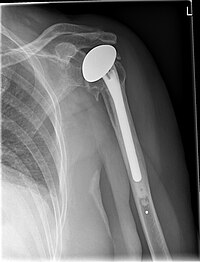
Photo from wikipedia
BACKGROUND Shoulder arthroplasty evolution has resulted in the shortening of traditional stemmed humeral components. Newer stemless implants rely on structures that maintain fixation in the metaphyseal region of the proximal… Click to show full abstract
BACKGROUND Shoulder arthroplasty evolution has resulted in the shortening of traditional stemmed humeral components. Newer stemless implants rely on structures that maintain fixation in the metaphyseal region of the proximal humerus. Whereas the overall morphology of the proximal humerus is well understood, the advent of stemless implants requires that additional geometric measures be assessed. This study's purpose was to introduce new anatomic measures to assist with the design of stemless implants. METHODS Using computed tomography data from 98 subjects (nonarthritic [n = 41], B2 osteoarthritic [n = 26], and symmetric osteoarthritic [n = 31]), shifts in proximal canal direction, bounding diameters along the canal, and canal depth beneath the center of the humeral resection plane were quantified. Traditional articular aspect ratio terms (ie, resection diameter, humeral head height) were also quantified. All measures were reported relative to a humeral coordinate system relevant to stemless implants. RESULTS Humeral depth, gender, and osteoarthritis were found to have effects on the measured parameters. Of these factors, gender was the most prominent, as men presented with significantly larger canal diameters and depths than women did (P < .001). Osteoarthritis had less of a significant impact on results (P < .001), with the attributed differences in canal path direction and articular aspect ratio being small in absolute value. Canal diameter was found to change significantly as a function of depth beneath the resection plane (P < .001). CONCLUSIONS This work quantified 3 new morphologic terms relevant to proximal humerus stemless arthroplasty. Together, these outcome measures help define the spatial limits for stemless humeral arthroplasty in an implant-relevant coordinate system.
Journal Title: Journal of shoulder and elbow surgery
Year Published: 2018
Link to full text (if available)
Share on Social Media: Sign Up to like & get
recommendations!